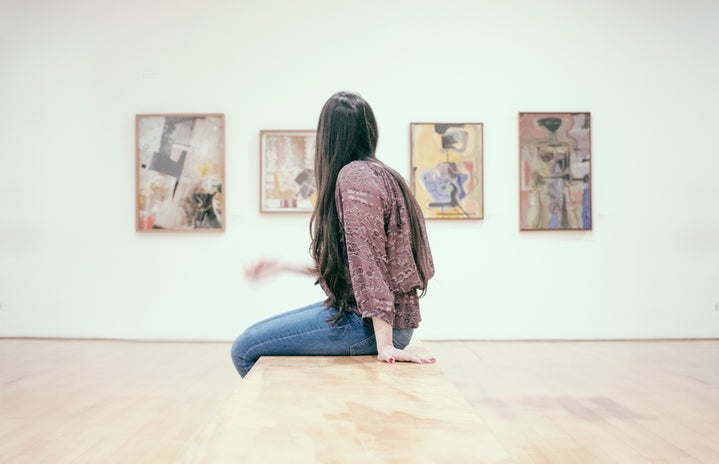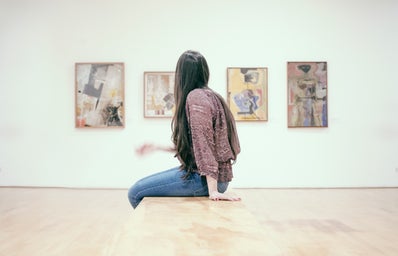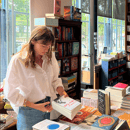On the sixth floor of the Museum of Modern Art, the walls are filled with striking images. A series of images of Venus, a striking portrait of a man standing in front of a deer, a still life of heirloom tomatoes on a windowsill, and, of course, Frank Ocean in the shower, one hand covering his face. The exhibition showcases the works of Wolfgang Tillmans, a German photographer focused on observation and experimenting with different mediums of photography. Many people are familiar with Tillmans’ work because he photographed Frank Ocean for his album Blonde, but his body of work spans a number of genres and aesthetics.
The installation features large scale prints and small photographs, some taped to the walls or pinned, many lacking proper frames. It’s a testament to the world that Tillmans lives in, making viewers feel like they are in his studio, or within his creative process itself. It also makes the exhibition feel less permanent, more alive. Like it could change at any given moment. Interesting videos and films are also on display throughout, featuring soundtracks seeking to fully submerge the audience in the visuals, almost hypnotically. It’s an incredibly large scale installation. It carries a sense of importance and grandeur from the second you enter.
One of the most interesting choices of the exhibition is the lack of wall text to accompany the art. Instead, people are offered brochures at the entrance that provide titles to each piece and occasionally short explanations. This choice is not uncommon for a Tillmans’ exhibition, but it is uncommon for typical exhibitions. The option to read explanations for the work is offered to the viewer, but it’s the viewer’s job to decide whether or not to take that explanation. It is possible to walk through the entire exhibition without a single piece of context or interpretation offered besides what the viewer sees with their own eyes. The meaning is left for the viewer to determine.
With photographs full of rich color and striking imagery, the installation raises questions about eroticism in war, human relationships, isolation, space, and bodies. Bodies are everywhere you look. Even when you’re looking at his abstractions, the innately human sense of aliveness is still apparent. This is a photographer deeply concerned with the human body and the way it connects, or doesn’t connect, with other bodies.
I visited this exhibition twice, and each time I got something different out of it. The first time, I went with my brother and his college friends. As a deeply artistic and creative group of people, they spent two hours wandering through the exhibition, taking their time on every wall and sitting with each piece carefully. My brother talked to me about how much he loved Tillmans’ Freischwimmer pieces, abstract pieces created in a darkroom by manipulating light. They appear as watercolors or some other kind of painting, but they were made entirely with photography tools.
My brother was inspired by the concept of being able to create a piece of abstract art with a tool so often used to depict life as realistically as possible. His friends spoke on how moved they were by pieces from Tillmans’ series Lighter, pieces of paper that have been crumpled and folded in different ways to warp the viewer’s perception of flatness and the two dimensionality of an image. They pointed out to me that these seemingly simple pieces of paper behind thick acrylic frames hold a very complex commentary on how we perceive photography and the reality of the art around us. Of course, this is just one reading of the art, and I’ve seen and read countless other analyses on these pieces, but my brother’s friends were able to sit with the art for a long time and come away with some kind of conclusive understanding that meant something to them.
The second time I saw the exhibition, I went with my best friend. She’s a massive fan of Frank Ocean, so she mostly went to see Frank, in the shower, and she admittedly doesn’t spend much time around modern art. My experience walking through the exhibition with her was vastly different than my first time. We weren’t analyzing every piece as closely, and we spent much less than two hours there, but I saw her interacting with the art in a much different way than either of us usually does in museums. When she saw Frank, in the shower in person, she stood in front of it silently for longer than I’d ever seen her do before at a museum. She was really moved by that image, and this happened several other times throughout the exhibition as well. We both had deeply personal encounters with the art that didn’t require any knowledge of photography or thought out analysis of our own reactions. We just appreciated the beauty and honesty of the images in front of us and let the art speak for itself.
Everyone will find something to love about Wolfgang Tillmans’ art, regardless of who you are or how you feel about modern art. The exhibition is on display through January 1st, 2023, and I cannot recommend it enough.


